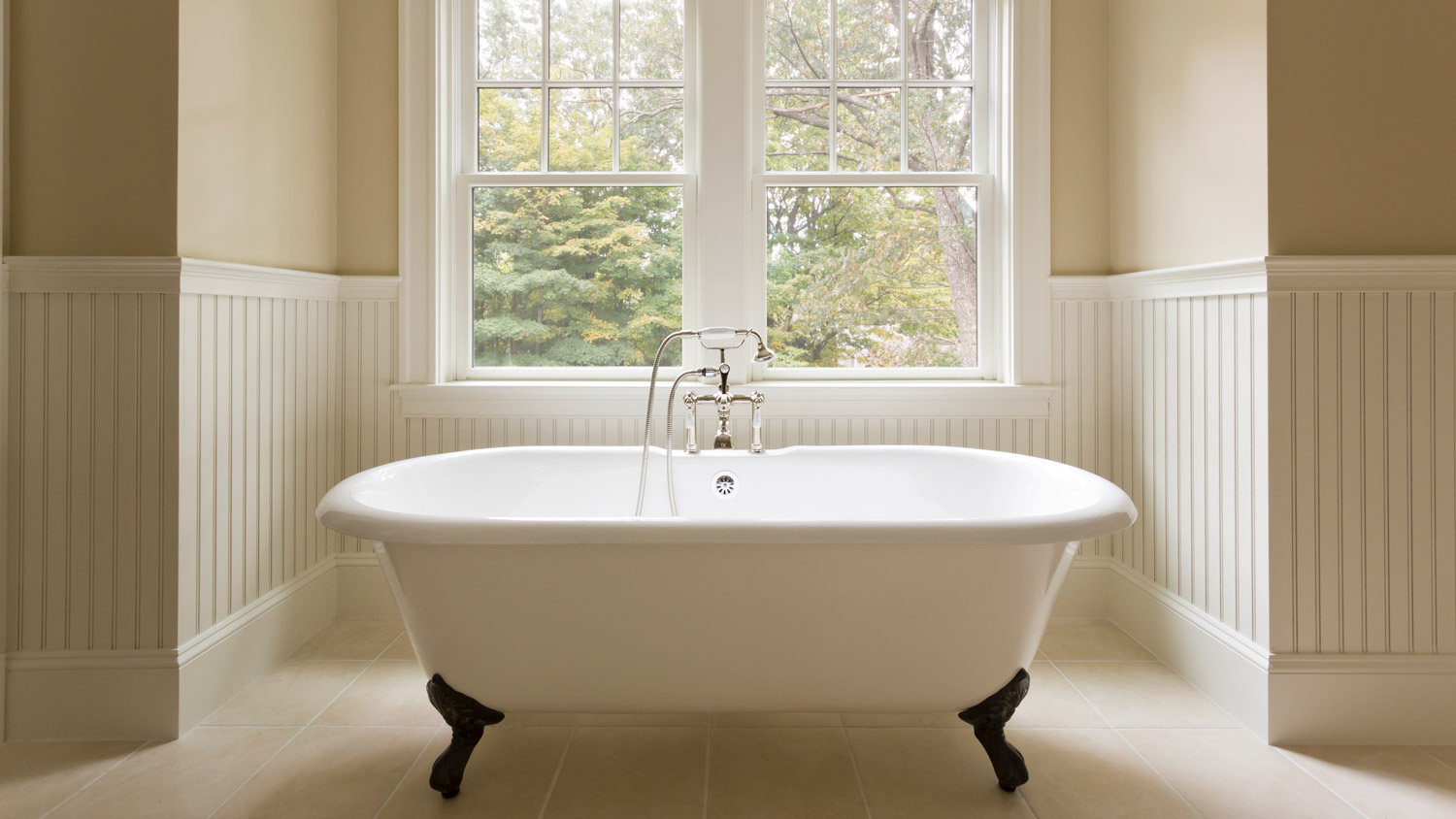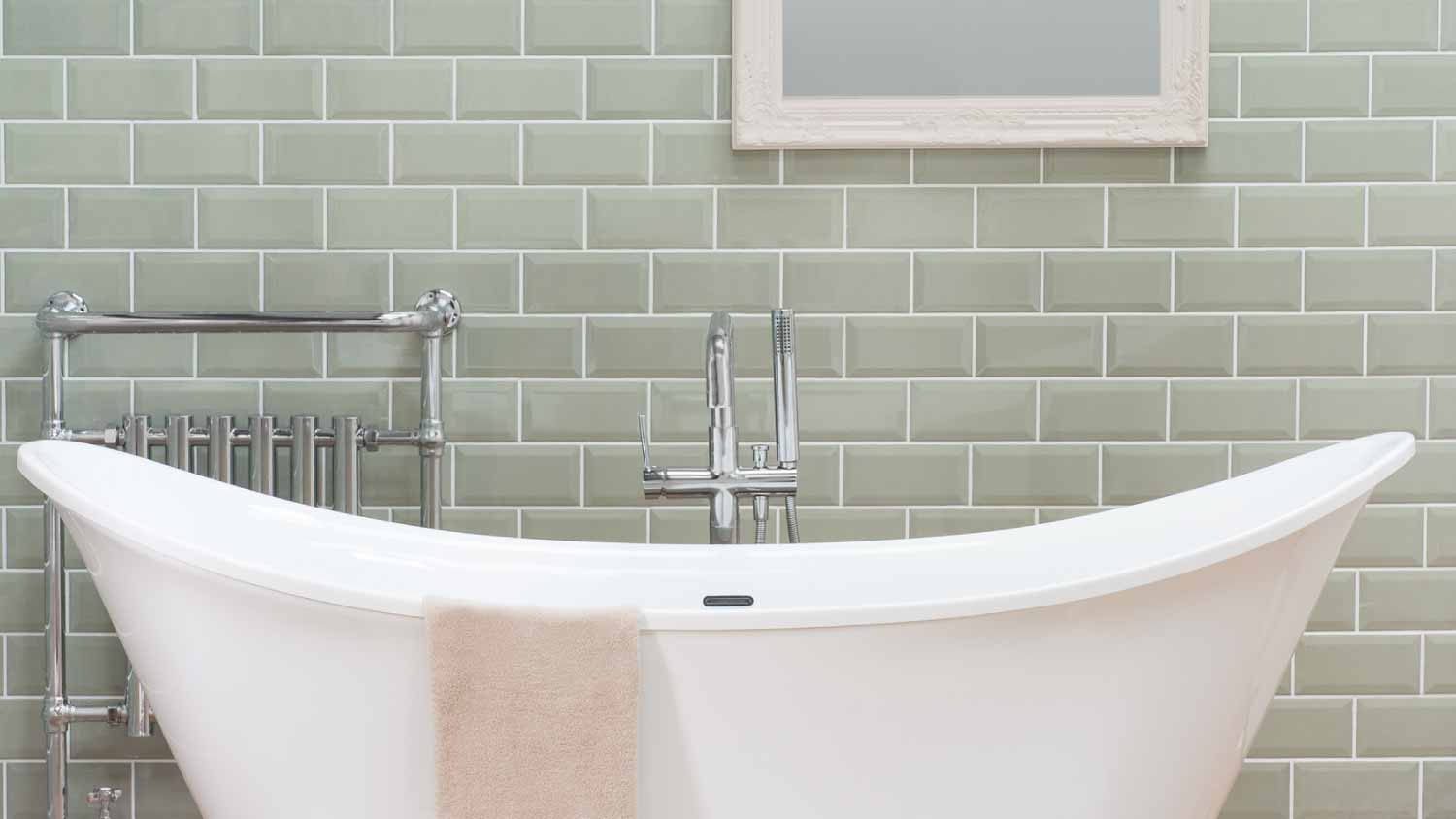
Building a laundry room addition to your home adds value and functionality. Your laundry room addition cost will depend on size, materials, and other factors.
Make your tub look new—without the brand-new price tag


This project can be costly in more ways than one. Hire a pro to get the job done right the first time, avoid potential injury, and eliminate budget-breaking DIY mistakes.
Replacing a bathtub can be a complicated and costly endeavor, so learning how to install a bathtub liner might be worth it if your tub is in good condition. You can float past a replacement, keep your budget intact, and enjoy a like-new bathtub. Here are nine steps to help you get your bathtub shiny again.

Clean your bathtub rigorously with a limescale remover. You can also make your own cleaner with a 1-to-1 ratio of vinegar and water. While cleaning, look for any signs of mold or rot. If you don’t take care of it now, your liner will seal it in place.
It’s also important that your tub is pristine and as clean as possible to get a secure adhesion. Any soap film or bath oil on the tub will prevent the adhesive from bonding correctly.
In addition to looking for mold or rot, check for any cracks or drainage issues in the tub. Take the time to repair any of these issues before installation. If it’s beyond your DIY abilities, hire a bathtub repair company near you.

Using a wrench or screwdriver, remove any objects or hardware on your tub, like nonslip strips, drain covers, and faucets. Now would be a great time to deep clean your showerhead or replace any outdated fixtures while you’re at it.
Do a dry fit of the bathtub insert before applying any adhesive to get comfortable with the installation process. The liner will come as one single piece of PVC or acrylic that will fit over your existing tub. You may need to trim some edges to create a perfect fit. If this is the case, carefully use a utility knife to remove any excess material.
Once the entire area is dry from the cleaning and you’re sure the liner fits, it’s time to start the installation. Start by applying butyl primer along all the areas the new liner will touch. Butyl primer is a high-tack primer designed to enhance maximum adhesion, which you’ll need for this task. Check the manufacturer’s instructions for drying times. Once the primer is dry, spread a silicone adhesive over all bathtub surfaces, especially around the drain and overflow areas.
Carefully set the liner into place. Apply ample pressure across all surfaces to ensure the liner connects with the adhesive. If necessary, place heavier objects on top of the liner or use a mallet wrapped in a towel to remove any trapped air.

Insert your silicone caulk into your caulk gun. Glide the tip along the edges of the liner, leaving a thin line of caulk as you go.
If you don’t have a steady hand, you can tape off the edge where the wall and tub meet, leaving about a 1/4 inch of space for the caulk. And don’t rush this step. Caulking around a bathtub establishes a seal to protect your walls from water damage and helps create a more finished look. You’ll thank yourself later for taking your time.
Reinstall the faucet and other hardware. For added peace of mind, clean the new liner, too. Just be careful to use only a little cleaning solution and keep any liquid away from the caulk or sealant.

For the best results, wait a day (or the recommended time in the manufacturer’s instructions) before using your new tub. This will allow the seal to bond correctly.
Bathtub liners are a cost-effective way to update your bathtub without paying for a replacement. Bathroom remodeling costs can add up quickly, so installing a tub liner could allow you to save and fund other upgrades like new cabinetry or lighting. This can really help you bring your bathroom remodel ideas to life.
Liners last for 3 to 5 years, so although it’s not a permanent solution, it can work well depending on your needs.
In most cases, it’s best to hire a pro to install the liner for you, so you can be sure it’s done properly and will have a long lifespan. Otherwise, make sure you have the DIY skills to get the job done right.
After installing a brand-new liner in your tub, you’ll want to help keep it in the best shape possible. The easiest way to do this is by cleaning it properly using the right products.
Although it might seem like a good idea to reach for common cleaning products on your shelves, it’s usually best to stick to something mild and simple, like dish soap or vinegar. If you want to do a thorough cleaning job, you can use diluted bleach.
Avoid abrasive cleaning products like harsh disinfectant cleaners or anything with acetone or aerosols. Don’t use rough cleaning pads either, as they can scratch your liner. Instead, use soft microfiber towels.
Tub liner installation costs $6,400 on average for materials and labor if you hire a pro. Costs depend on whether you choose an acrylic or PVC liner, the size of your tub, and if you need repairs done before the installation. The other common alternative to installing a liner is refinishing the tub. On average, bathtub refinishing costs $480.
In comparison, a new tub replacement costs $2,000 to $9,400. If your bathtub is in poor condition, a local bathtub installer can give you a quote and refresh your bathroom with a new tub.
While you can save on the cost of labor and the steps in this project aren’t necessarily complicated, there are a few risks you must be aware of if you decide to tackle this on your own. The biggest issue you may face is ensuring a tight, waterproof seal. If you skimp on the adhesive or skip a step altogether, you risk trapping water underneath the liner—which can lead to unsanitary conditions, stinky smells, and even health issues like mold.
Hire a bathtub refinishing pro near you or a plumber if you want someone knowledgeable to take on this job. If you have any other plumbing issues that need fixing during this project, you will likely pay between $45 and $200 for a plumber’s hourly rate on top of the liner installation.
Nathaniel and Austin did a really great job. They were very professional and were careful with our furniture.
I recently hired American Arborist for a large tree removal project, and I couldn’t be more impressed with the entire experience. From the first phone call to the final cleanup, their team was professional, efficient, and incredibly knowledgeable. We had a towering oak that was not only...
Robert also provides my lawn care. He pays attention to detail, is a pleasure to work with. I am so happy with the patio he built and the lawn care he provides. Very trust worthy and fabulous!
Iâ ve hired twice now, trying to get my huge living room/kitchen/office area done. Both times the difference between before and after was amazing!
Very polite and punctual. Kept me informed of costs before he did the work. Charged me what he said he would and advised me on future needs. Very professional!
Reliable, Affordable and fast service. Job well done
Perfect service. Fast and courteous. Very effective.
Mr. Bylers did our cabinets and island for a large kitchen remodel about 7 years ago. The quality is top notch. Mr. Byler is a consummate professional and amazing cabinet maker. You will not be disappointed! Very highly recommend. We downsized this year and the hardest part was leaving the...
Absolutely the best! Super professional pays attention to the tiniest details and doesnt miss anything
Great customer service and quality service!
From average costs to expert advice, get all the answers you need to get your job done.

Building a laundry room addition to your home adds value and functionality. Your laundry room addition cost will depend on size, materials, and other factors.

If your bathroom needs sprucing up, a new vanity will make a big difference. Vanity installation costs depend on the size and type of the countertops and fixtures you choose.

The cost of installing a bathtub or a shower liner depends on the type of tub or shower, size, and features. This guide will show what you can expect to pay for your project.

Discover how to dispose of old countertops, including removing, recycling, and donating. Our expert guide has all the info for DIYing or hiring a pro.

An updated bathtub can give a bathroom a whole new look. Find out how much it costs to replace a bathtub in San Francisco, CA, including prices by type and labor costs.

An updated bathtub can give a bathroom a whole new look. Find out how much it costs to replace a bathtub in Phoenix, AZ, including prices by type and labor costs.